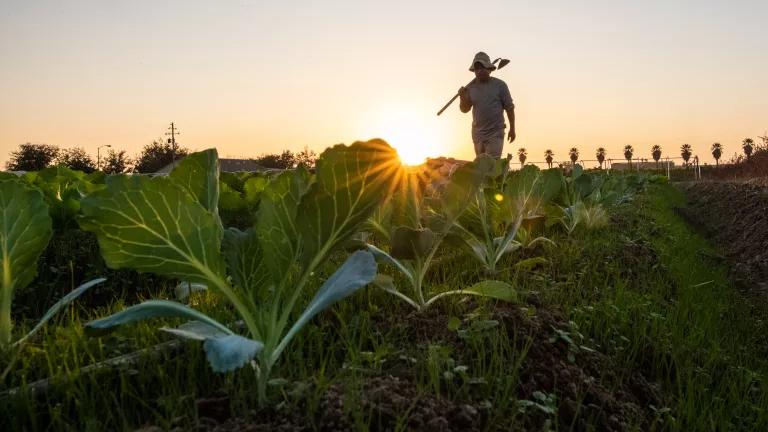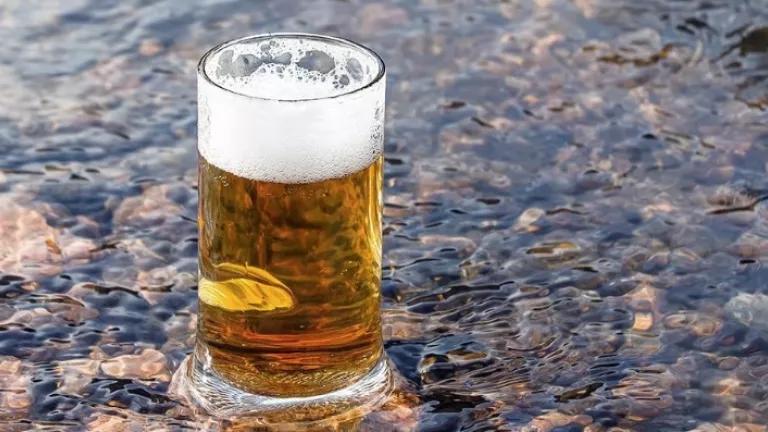
Better riparian management practices, including the use of a cattle crossing and stream fencing, were used to restore the aquatic and riparian habitat along this reach of Oostanaula Creek, TN while still providing cattle watering access.
University of Tennessee Institute of Agriculture
NRDC believes that better beef must meet credible, independent standards of responsible production at each step to your plate. The overwhelming scientific consensus shows that the most important impacts to reduce and minimize occur on grazing and feedlot operations.
Why it matters that all beef—from conventional to grass-fed—is produced on well-managed grazing operations
A growing number of ranchers and farmers are improving their land management using science and the experiences of other ranchers. As a result, their ranches are more productive and local ecosystems are thriving as they support healthy soils, water quality, and plant and animal life. These leaders are demonstrating how beef producers can help conserve and restore America's grasslands and other grazed ecosystems.
Well-managed grazing operations generate environmental and business benefits
Well-managed grazinglands, which include both rangelands (grazed natural grasslands and other ecosystems, mostly in the western United States) and pastures (farmland planted with grass to graze livestock, mostly in the eastern United States), provide valuable ecosystem services, including:
- Reducing carbon pollution by storing it in soil: Scientists have found that land converted from crops to well-managed grazed grassland absorbed enough carbon in its soil to offset all other emissions from the beef produced on that land.
- Filtering rainfall runoff to maintain and restore water quality: Healthy vegetation on well-managed grazing lands cleanses runoff by trapping sediment before it can reach waterways, while erosion and runoff on poorly managed pasture pollutes surface waters.
- Enhancing recharge of ground and surface waters: Healthy grasses enable ranchers to get more out of every raindrop by slowing runoff, so that more rainwater is absorbed into the soil instead of flowing off the pasture and into waterways. Healthy soils absorb water like a sponge, keeping more in the system to support productive grasses and livestock—and native plants and wildlife. This reduces ranch and farm vulnerability to droughts and floods.
- Conserving our national heritage and protecting biodiversity: Well-managed ranches provide good wildlife habitat and brilliant displays of native wildflowers.
- Providing recreational opportunities: Livestock management practices that reduce erosion and improve water quality help make lakes and rivers cleaner for swimming, fishing, and boating.
- Conserving scenic landscapes: Which would you rather see from the highway: rows of cookie-cutter condos and degraded eroding pastures or healthy grasslands? Well-managed ranching can help conserve and restore these scenic landscapes.
Poorly-managed cattle grazing operations degrade a massive chunk of American lands
More than 780 million acres of American lands—an area twice the size of Alaska—are grazed by livestock (mostly beef cattle), and scientists estimate that more than half of these lands are poorly managed. By purchasing verifiably better beef, consumers can avoid contributing to the environmental costs of this poor management, including:
- Climate change: According to a University of Nebraska expert, U.S. beef production generates more than 4 times the climate-disrupting impact (17 lbs CO2eq/lb beef) of pork (4 lbs CO2eq/lb) and more than ten times the impact of chicken (1.5 lbs CO2eq/lb). Other studies have found beef's carbon hoofprint to be even more substantial.

This rangeland plant community, on U.S. Bureau of Land Management lands in Nevada's Ruby Mountains, shows the effects of overgrazing: diminished vegetation health, large areas of bare ground, and degraded native plant and wildlife habitats.
G. Wuerthner
- Soil erosion: According to a Cornell University study, one hectare of overgrazed pasture can lose more than 100 tons of soil to erosion per year, more than 16 times that of well-managed pasturelands. The authors estimated that 54 percent of U.S. pastureland is being overgrazed.
- Surface and groundwater pollution: Top polluters of rivers and streams assessed by the U.S. EPA include "grazing in riparian zone or shoreline zones" (33,045 miles), "livestock (grazing or feeding operations)" (20,720 miles), "animal feeding operations" (18,896 miles) and "rangeland grazing" (18,558 miles).
- Inefficient water use depletes reservoirs and groundwater supplies: In California, the nearly 1 million acres of irrigated pasture require as much water as a city the size of Shanghai.
- Impacts on America's plant and wildlife communities: Scientists estimate that poor grazing management contributes to the decline of 22 percent of threatened and endangered species, nearly as many as logging (12 percent) and mining (11 percent) combined.
- Environmental and economic impacts of weed invasions: When poor ranch management causes weed invasions, the weeds not only displace our precious native plants and wildlife, but force ranchers and farmers to spend money to control them (over $100 million each year in Montana alone) with toxic herbicides that, in turn, can wash into and pollute our waterways.
- Land conversion: In the United States, 23.6 million acres of grasslands, wetlands and shrublands were converted to row crops (particularly corn, much of which ends up as feed for farm animals)—between 2008 and 2011 alone. This and other forms of conversion of natural ecosystems to accommodate beef production are destroying our precious grassland heritage and releasing large amounts of carbon from the soil (where it is beneficial) into the atmosphere (where it accelerates climate change).
- Vulnerability to drought: These impacts of poor management make our grazinglands more vulnerable to drought. When it is too dry to grow enough grass to feed the cattle, ranchers have to feed them hay (often termed "supplemental feed"). Scientists estimate that climate change could increase supplemental feed costs by up to $235 million per year for California's ranching industry alone.
How you can help
By choosing to purchase beef produced in a better way, YOU are supporting the forward-thinking retailers, ranchers, and feedlots and improving the supply chain.



